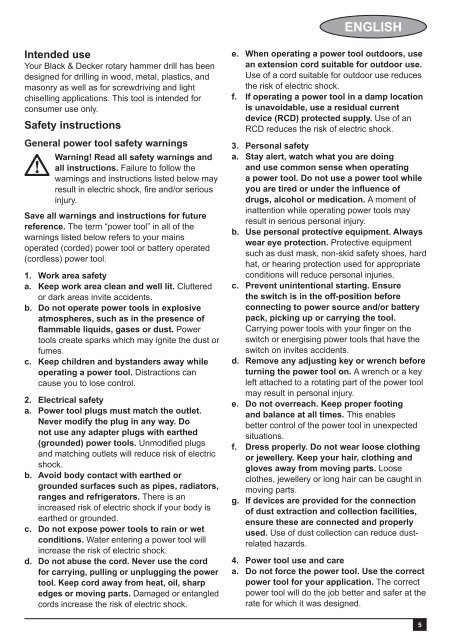BlackandDecker Marteau Rotatif- Kd855 - Type 1 - Instruction Manual (Européen)
BlackandDecker Marteau Rotatif- Kd855 - Type 1 - Instruction Manual (Européen)
BlackandDecker Marteau Rotatif- Kd855 - Type 1 - Instruction Manual (Européen)
Create successful ePaper yourself
Turn your PDF publications into a flip-book with our unique Google optimized e-Paper software.
ENGLISH<br />
Int<strong>en</strong>ded use<br />
Your Black & Decker rotary hammer drill has be<strong>en</strong><br />
designed for drilling in wood, metal, plastics, and<br />
masonry as well as for screwdriving and light<br />
chiselling applications. This tool is int<strong>en</strong>ded for<br />
consumer use only.<br />
Safety instructions<br />
G<strong>en</strong>eral power tool safety warnings<br />
Warning! Read all safety warnings and<br />
all instructions. Failure to follow the<br />
warnings and instructions listed below may<br />
result in electric shock, fi re and/or serious<br />
injury.<br />
Save all warnings and instructions for future<br />
refer<strong>en</strong>ce. The term “power tool” in all of the<br />
warnings listed below refers to your mains<br />
operated (corded) power tool or battery operated<br />
(cordless) power tool.<br />
1. Work area safety<br />
a. Keep work area clean and well lit. Cluttered<br />
or dark areas invite accid<strong>en</strong>ts.<br />
b. Do not operate power tools in explosive<br />
atmospheres, such as in the pres<strong>en</strong>ce of<br />
flammable liquids, gases or dust. Power<br />
tools create sparks which may ignite the dust or<br />
fumes.<br />
c. Keep childr<strong>en</strong> and bystanders away while<br />
operating a power tool. Distractions can<br />
cause you to lose control.<br />
2. Electrical safety<br />
a. Power tool plugs must match the outlet.<br />
Never modify the plug in any way. Do<br />
not use any adapter plugs with earthed<br />
(grounded) power tools. Unmodifi ed plugs<br />
and matching outlets will reduce risk of electric<br />
shock.<br />
b. Avoid body contact with earthed or<br />
grounded surfaces such as pipes, radiators,<br />
ranges and refrigerators. There is an<br />
increased risk of electric shock if your body is<br />
earthed or grounded.<br />
c. Do not expose power tools to rain or wet<br />
conditions. Water <strong>en</strong>tering a power tool will<br />
increase the risk of electric shock.<br />
d. Do not abuse the cord. Never use the cord<br />
for carrying, pulling or unplugging the power<br />
tool. Keep cord away from heat, oil, sharp<br />
edges or moving parts. Damaged or <strong>en</strong>tangled<br />
cords increase the risk of electric shock.<br />
e. Wh<strong>en</strong> operating a power tool outdoors, use<br />
an ext<strong>en</strong>sion cord suitable for outdoor use.<br />
Use of a cord suitable for outdoor use reduces<br />
the risk of electric shock.<br />
f. If operating a power tool in a damp location<br />
is unavoidable, use a residual curr<strong>en</strong>t<br />
device (RCD) protected supply. Use of an<br />
RCD reduces the risk of electric shock.<br />
3. Personal safety<br />
a. Stay alert, watch what you are doing<br />
and use common s<strong>en</strong>se wh<strong>en</strong> operating<br />
a power tool. Do not use a power tool while<br />
you are tired or under the influ<strong>en</strong>ce of<br />
drugs, alcohol or medication. A mom<strong>en</strong>t of<br />
inatt<strong>en</strong>tion while operating power tools may<br />
result in serious personal injury.<br />
b. Use personal protective equipm<strong>en</strong>t. Always<br />
wear eye protection. Protective equipm<strong>en</strong>t<br />
such as dust mask, non-skid safety shoes, hard<br />
hat, or hearing protection used for appropriate<br />
conditions will reduce personal injuries.<br />
c. Prev<strong>en</strong>t unint<strong>en</strong>tional starting. Ensure<br />
the switch is in the off-position before<br />
connecting to power source and/or battery<br />
pack, picking up or carrying the tool.<br />
Carrying power tools with your fi nger on the<br />
switch or <strong>en</strong>ergising power tools that have the<br />
switch on invites accid<strong>en</strong>ts.<br />
d. Remove any adjusting key or wr<strong>en</strong>ch before<br />
turning the power tool on. A wr<strong>en</strong>ch or a key<br />
left attached to a rotating part of the power tool<br />
may result in personal injury.<br />
e. Do not overreach. Keep proper footing<br />
and balance at all times. This <strong>en</strong>ables<br />
better control of the power tool in unexpected<br />
situations.<br />
f. Dress properly. Do not wear loose clothing<br />
or jewellery. Keep your hair, clothing and<br />
gloves away from moving parts. Loose<br />
clothes, jewellery or long hair can be caught in<br />
moving parts.<br />
g. If devices are provided for the connection<br />
of dust extraction and collection facilities,<br />
<strong>en</strong>sure these are connected and properly<br />
used. Use of dust collection can reduce dustrelated<br />
hazards.<br />
4. Power tool use and care<br />
a. Do not force the power tool. Use the correct<br />
power tool for your application. The correct<br />
power tool will do the job better and safer at the<br />
rate for which it was designed.<br />
5
















